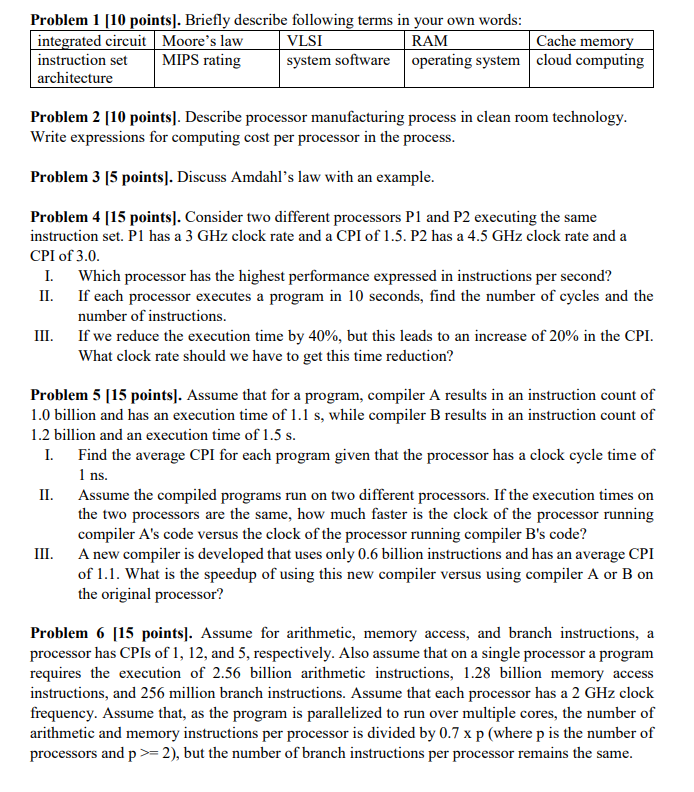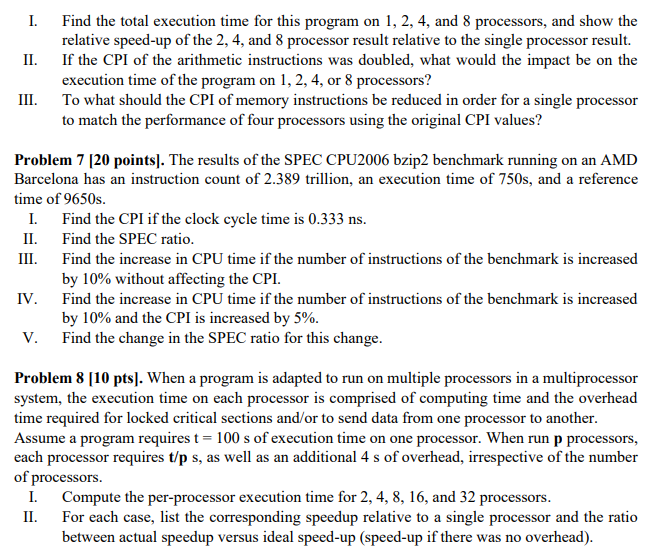Computer Organization and Design
1.David Patterson and John Hennessy, "Computer Organization and Design ARM Edition, Hardware and Software Interface", 1st Edition, Morgan Kaufmann, ISBN: 9780128017333
2.Sarah Harris and David Harris, "Digital Design and Computer Architecture, ARM Edition", 1st Edition, Morgan Kaufmann, ISBN: 9780128000564


Problem 1 [10 points]. Briefly describe following terms in your own words integrated circuit Moore's law instruction set MIPS rating VLSI RAM Cache memo system software operating system cloud computing architecture Problem 2 [10 points]. Describe processor manufacturing process in clean room technology rite expressions for computing cost per processor in the process Problem 3 [5 points]. Discuss Amdahl's law with an example Problem 4 15 points|. Consider two different processors P1 and P2 executing the same instruction set. P1 has a 3 GHz clock rate and a CPI of 1.5. P2 has a 4.5 GHz clock rate and a CPI of 3.0 I. Which processor has the highest performance expressed in instructions per second? I If each processor executes a program in 10 seconds, find the number of cycles and the number of instructions. If we reduce the execution time by 40%, but this leads to an increase of 20% in the CPI. What clock rate should we have to get this time reduction Ill. Problem 5 115 points]. Assume that for a program, compiler A results in an instruction count of 1.0 billion and has an execution time of 1.1 s, while compiler B results in an instruction count of I. Find the average CPI for each program given that the processor has a clock cycle time of Assume the compiled programs run on two different processors. If the execution times on 1.2 billion and an execution time of 1.5s ns. the two processors are the same, how much faster is the clock of the processor running compiler A's code versus the clock of the processor running compiler B's code? A new compiler is developed that uses only 0.6 billion instructions and has an average CPI of 1.1. What is the speedup of using this new compiler versus using compiler A or B on the original processor? Problem 6 [15 points]. Assume for arithmetic, memory access, and branch instructions, a processor has CPIs of1, 12, and 5, respectively. Also assume that on a single processor a program requires the execution of 2.56 billion arithmetic instructions, 1.28 billion memory access instructions, and 256 million branch instructions. Assume that each processor has a 2 GHz clock frequency. Assume that, as the program is parallelized to run over multiple cores, the number of arithmetic and memory instructions per processor is divided by 0.7 x p (where p is the number of processors and p 2), but the number of branch instructions per processor remains the same I. Find the total execution time for this program on 1, 2, 4, and 8 processors, and show the I If the CPI of the arithmetic instructions was doubled, what would the impact be on the III. relative speed-up of the 2, 4, and 8 processor result relative to the single processor result. execution time of the program on 1, 2, 4, or 8 processors? To what should the CPI of memory instructions be reduced in order for a single processor to match the performance of four processors using the original CPI values? Problem 7 120 points]. The results of the SPEC CPU2006 bzip2 benchmark running on an AMD Barcelona has an instruction count of 2.389 trillion, an execution time of 750s, and a reference time of 9650s I. Find the CPI if the clock cycle time is 0.333 ns. II Find the SPEC ratio III Find the increase in CPU time if the number of instructions of the benchmark is increased by 10% without affecting the CPI. Find the increase in CPU time if the number of instructions of the benchmark is increased by 10% and the CPI is increased by 5%. Find the change in the SPEC ratio for this change IV. V. Problem 8 [10 pts|. When a program is adapted to run on multiple processors in a multiprocessor system, the execution time on each processor is comprised of computing time and the overhead time required for locked critical sections and/or to send data from one processor to another Assume a program requirest-100 s of execution time on one processor. When run p processors, each processor requires t/p s, as well as an additional 4 s of overhead, irrespective of the number of processors. I. Compute the per-processor execution time for 2, 4, 8, 16, and 32 processors II For each case, list the corresponding speedup relative to a single processor and the ratio between actual speedup versus ideal speed-up (speed-up if there was no overhead) Problem 1 [10 points]. Briefly describe following terms in your own words integrated circuit Moore's law instruction set MIPS rating VLSI RAM Cache memo system software operating system cloud computing architecture Problem 2 [10 points]. Describe processor manufacturing process in clean room technology rite expressions for computing cost per processor in the process Problem 3 [5 points]. Discuss Amdahl's law with an example Problem 4 15 points|. Consider two different processors P1 and P2 executing the same instruction set. P1 has a 3 GHz clock rate and a CPI of 1.5. P2 has a 4.5 GHz clock rate and a CPI of 3.0 I. Which processor has the highest performance expressed in instructions per second? I If each processor executes a program in 10 seconds, find the number of cycles and the number of instructions. If we reduce the execution time by 40%, but this leads to an increase of 20% in the CPI. What clock rate should we have to get this time reduction Ill. Problem 5 115 points]. Assume that for a program, compiler A results in an instruction count of 1.0 billion and has an execution time of 1.1 s, while compiler B results in an instruction count of I. Find the average CPI for each program given that the processor has a clock cycle time of Assume the compiled programs run on two different processors. If the execution times on 1.2 billion and an execution time of 1.5s ns. the two processors are the same, how much faster is the clock of the processor running compiler A's code versus the clock of the processor running compiler B's code? A new compiler is developed that uses only 0.6 billion instructions and has an average CPI of 1.1. What is the speedup of using this new compiler versus using compiler A or B on the original processor? Problem 6 [15 points]. Assume for arithmetic, memory access, and branch instructions, a processor has CPIs of1, 12, and 5, respectively. Also assume that on a single processor a program requires the execution of 2.56 billion arithmetic instructions, 1.28 billion memory access instructions, and 256 million branch instructions. Assume that each processor has a 2 GHz clock frequency. Assume that, as the program is parallelized to run over multiple cores, the number of arithmetic and memory instructions per processor is divided by 0.7 x p (where p is the number of processors and p 2), but the number of branch instructions per processor remains the same I. Find the total execution time for this program on 1, 2, 4, and 8 processors, and show the I If the CPI of the arithmetic instructions was doubled, what would the impact be on the III. relative speed-up of the 2, 4, and 8 processor result relative to the single processor result. execution time of the program on 1, 2, 4, or 8 processors? To what should the CPI of memory instructions be reduced in order for a single processor to match the performance of four processors using the original CPI values? Problem 7 120 points]. The results of the SPEC CPU2006 bzip2 benchmark running on an AMD Barcelona has an instruction count of 2.389 trillion, an execution time of 750s, and a reference time of 9650s I. Find the CPI if the clock cycle time is 0.333 ns. II Find the SPEC ratio III Find the increase in CPU time if the number of instructions of the benchmark is increased by 10% without affecting the CPI. Find the increase in CPU time if the number of instructions of the benchmark is increased by 10% and the CPI is increased by 5%. Find the change in the SPEC ratio for this change IV. V. Problem 8 [10 pts|. When a program is adapted to run on multiple processors in a multiprocessor system, the execution time on each processor is comprised of computing time and the overhead time required for locked critical sections and/or to send data from one processor to another Assume a program requirest-100 s of execution time on one processor. When run p processors, each processor requires t/p s, as well as an additional 4 s of overhead, irrespective of the number of processors. I. Compute the per-processor execution time for 2, 4, 8, 16, and 32 processors II For each case, list the corresponding speedup relative to a single processor and the ratio between actual speedup versus ideal speed-up (speed-up if there was no overhead)








